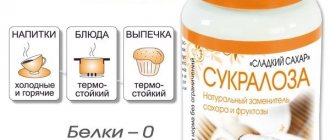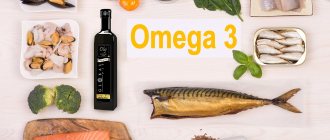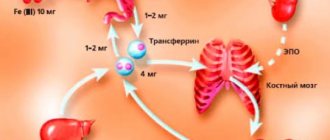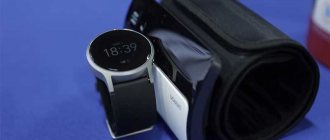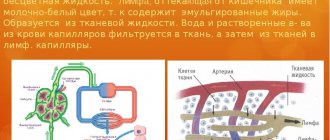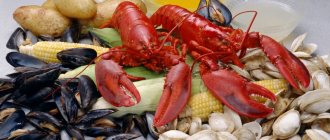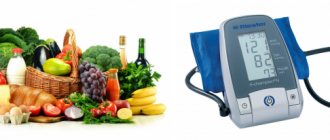Table of foods containing iron
Creating a menu of iron-rich foods requires taking into account the different bioavailability of the heme or chelate variety.
The body absorbs iron most quickly and completely from beef, lamb, turkey, liver, and fish.
Despite the high iron content in plant foods - for example, beans - its absorption is much poorer.
Foods containing iron are presented in Table 1:
Table 1. Which foods contain a lot of iron
| Product | Iron content (mg) per 100 g of product |
| Pork liver | 20 |
| Beans | 10-20 |
| Mushrooms | 17 |
| Beer shakes | 17 |
| Cocoa | 12 |
| Pumpkin seeds | 11 |
| Beef | 9 |
| Greenery | 9 |
| Wheat germ | 8 |
| Lentils | 7 |
| Sunflower seeds | 6 |
| Spinach | 4 |
| Jerusalem artichoke | 4 |
| Rye bread | 3 |
| Sea fish | 2,4 |
| Salo | 2,3 |
Therefore, it is useful to combine legumes - beans, peas - with lean meat for more complete absorption of iron from these products.
Iron absorption is accelerated by:
- fruits - lemon, orange, apple, pineapple, strawberry, cherry, raspberry, strawberry, plum, currant, peaches;
- vegetables - fresh cucumbers, red bell pepper, basil, parsley, dill.
The absorption of non-heme iron, which is contained in plant foods, is facilitated by vitamin C.
Vegetables rich in non-heme iron: green onions, tops of radishes, mustard, carrots, dandelion leaves, nettles, sorrel. There is a lot of it in green peas, raw tomatoes, cabbage, garlic, lentils, lettuce, horseradish, beans, and cucumbers.
There is a lot of iron in dried apricots, raisins, nuts, pumpkin and sunflower seeds.
Nettle is rich in iron; it has long been used to treat anemia:
Before flowering, collect leaves and stems, wash and dry. Pass through a juicer or mixer to obtain juice.
Take up to 3 tbsp. per day, along with honey.
Contraindications for treatment with nettle: increased blood clotting, thrombophlebitis, pregnancy.
Reduce iron absorption:
- dairy products, cheeses due to their high calcium content;
- potatoes, rice;
- egg white;
- vegetable protein from cereals.
It is worth giving up the habit of drinking tea or coffee immediately after meals. These products contain tannin, which binds iron and interferes with its absorption.
Vegetables that are rich in iron
A real salvation for vegans and vegetarians are vegetables rich in iron. And the high amount of fiber and low fat content makes them the number one product for those who want to lose excess weight. An important factor that distinguishes vegetables from meat is that heat treatment does not affect the iron content in vegetables; it remains in the same amount. Which foods contain the most iron? Jerusalem artichoke takes first place in terms of iron content, asparagus comes in second, and the most common garlic takes an honorable third place.
Interaction with other substances
Calcium
It inhibits iron absorption. For maximum absorption, iron supplements should be taken two hours apart from calcium-fortified foods (milk, cheese).
Zinc
Zinc deficiency
7 Zinc Deficiency Symptoms and Risk Factors
associated with iron deficiency anemia and aggravates its symptoms. Taking iron supplements and
zinc
Zinc: benefits for the body - symptoms, sources, side effects How does zinc affect our body? What diseases can occur with a deficiency of this element and what are the symptoms of deficiency? Products containing zinc and side effects.
on an empty stomach, may interfere with the absorption of the latter. This effect does not occur when these substances are combined during meals.
.
This is interesting: Zinc - 10 foods with high content The article shows 10 accessible and inexpensive food products that will help saturate the body with zinc. What are the contraindications and overdose of zinc, how is it compatible with foods and medications.
Read more…
Vitamin C
Ascorbic acid increases the absorption of non-heme iron in the intestine. This affects the storage and transportation of the element in the body.
Iodine
Severe iron deficiency anemia can interfere with iodine metabolism and the production of thyroid hormones. Scientific research has confirmed that a combination of iodine and iron supplements improves thyroid function
.
Aluminum
Iron depletion increases aluminum absorption. Susceptible people (patients with kidney failure) have an increased risk of aluminum poisoning if they have iron deficiency.
FEATURES OF ABSORPTION OF DIFFERENT FORMS OF IRON
Heme iron compounds are released from protein chains under the action of digestive enzymes. And the resulting metalloporphyrin is absorbed by enterocytes (epithelial cells of the small intestine). Inside them, iron is released and oxidized from a divalent to a trivalent state. In this form, it binds to the transferrin protein and enters the blood. The bioavailability of heme iron can reach 50%, with an average of 30%.
A different mechanism is used for the absorption of non-heme compounds. In the stomach, divalent iron ions bind to a special protein called gastroferrin and are transported to the intestine. The absorption process occurs with the help of a nonspecific proton-dependent ion transporter. But this transporter is also involved in the transfer of copper, zinc and other divalent cations. This may be a factor limiting the availability of iron from non-heme compounds. Other ions will compete with iron, slowing down its absorption in the intestines.
Percentage of iron absorption from foods
The body does not produce iron on its own, so it must constantly be replenished with the help of special medications or products. In our body, the amount of hemoglobin ranges from 2.5-4.5 mg, and if reserves are not replenished, the disease begins to progress.
Hemoglobin is absorbed by 35% from foods that help saturate the blood with oxygen and improve the viability of red blood cells. However, it is worth considering that there are several types of iron, namely heme (divalent) and non-heme (trivalent).
Heme-containing (heme) iron.
This type is mainly found in meat products. Most of all it is found in beef and veal liver, as well as in eggs and white fish. This type of iron is absorbed by 20-30% by our body, which is quite capable of satisfying its daily requirement.
Non-heme-containing (non-heme) iron.
Non-heme can be obtained from plants, that is, from fruits and vegetables, which contain approximately 10% of the essential element for anemia. Such products are recommended for consumption by vegetarians; they are the ones who most often suffer from anemia, since their diet does not contain animal products with a high percentage of absorption.
Unlike heme-containing iron, non-heme-containing iron is absorbed by the human body much better and faster. It is not without reason that recently more and more people are switching to vegetarianism, thereby replacing animal protein with plant protein. This type of iron is found in most fruits and vegetables, legumes, garlic and horseradish are rich in it. An important nuance: when consuming plant foods, protein absorption depends on accompanying products, namely, citrus fruits promote better absorption of non-heme iron, and dairy products can reduce its level in the blood. Therefore, you should eat more varied foods and not limit your diet.
What affects iron absorption
Enriching the diet with foods high in microelements does not always compensate for its deficiency in the body. There are foods that interfere with the absorption of the substance. This includes products with polyphenols, calcium and tannin. This fact should definitely be taken into account by those who suffer from iron deficiency.
Dairy products do not contain this microelement, are rich in calcium, and, therefore, lead to a decrease in the substance obtained from food. Strong tea and coffee are not the best allies of iron. Lovers of these drinks should get into the habit of postponing the enjoyment of a cup of invigorating coffee or tea until later after a meal. In general, it is better to replace Coca-Cola with dried fruit compotes or rosehip infusion.
Full table of iron content in foods - with level of adaptation
| Food product | Iron content | Percentage of absorption |
| Dried mushrooms | 35.0 mg | |
| Shellfish | 20.0 mg | |
| Sea kale | 16.0 mg | |
| Cocoa powder | 14.8 mg | 2-3% |
| Lentils | 10-12 mg | |
| Pork liver | 12.6 mg | 12-16% |
| Rose hip | 11.5 mg | |
| Wheat bran | 10.7 mg | |
| Soybeans | 10 mg | |
| Beef liver | 7.0-9.0 mg | 12-16% |
| White beans | 8-10 mg | |
| Peas | 6.8 mg | 2-3% |
| Buckwheat | 6.7-7.8 mg | |
| Oatmeal (coarsely ground) | 7.8 mg | |
| Cashew nuts | 7.0 mg | |
| Beef kidneys | 5.9 mg | 12-16% |
| Beans | 5.9 mg | 2-3% |
| Fresh mushrooms | 5.2 mg | |
| Dark chocolate | 5.0 mg | 2-3% |
| Peanut | 5.0 mg | |
| Beef heart | 4.7 mg | 12-16% |
| Rabbit meat | 4.4 mg | |
| Peaches | 4.1 mg | |
| Turkey meat | 4.0 mg | |
| Pork heart | 4.0 mg | 12-16% |
| Beef tongue | 4.0-5.0 mg | 12-16% |
| Oat groats | 3.9 mg | |
| Rye bread | 3.9 mg | |
| Dried apricots | 3.2 mg | 2-3% |
| Raisin | 3.0 mg | 2-3% |
| Prunes | 3.0 mg | 2-3% |
| Hazelnut | 3.0 mg | |
| Chicken's meat | 3.0 mg | |
| Beef | 2.9 mg | |
| Spinach | 2.7 mg | 1% |
| Chicken egg | 2.5 mg | 2-3% |
| Mackerel | 2.3 mg | 9-11% |
| Walnuts | 2.3 mg | |
| Pear | 2.2 mg | 2-3% |
| Apples | 2.2 mg | 2-3% |
| Pork | 1.9 mg | |
| Cod liver | 1.9 mg | 9-11% |
| Beet | 1.4 mg | |
| Cauliflower | 1.4 mg | |
| Carrot | 1.2 mg |
***
Iron is a trace mineral needed by the body to produce hemoglobin and transport oxygen to tissues. It must be supplied with food, since it cannot be synthesized by the body. The most iron-rich foods are seafood, seaweed and animal liver. This micromineral is also found in large quantities in legumes and pseudocereals.
- Iron overview for health professionals. Research health effects, dosing, sources, deficiency symptoms, side effects, and interactions, source
Material rating:
Iron in foods - daily values. Iron content in food products,
4.33 / 6
You need to enable JavaScript to vote
Foods with which iron is better absorbed
Every day the body loses about 1-2 mg of iron; to replenish the supply, you need to regularly consume foods rich in this microelement. Loss of iron through menstrual blood should be taken into account in premenopausal women. Weight gain during fetal, childhood, and adolescence may temporarily increase iron requirements.
- Sources of heme iron (red meat, chicken, fish).
Vitamin C
Ascorbic acid
Vitamin C: 7 beneficial properties for the body. Scientific facts and myths. The article presents the results of scientific research on the effect of vitamin C on the human body. Proven and unproven facts about the benefits of vitamin C.
is the only nutrient that improves the absorption of iron from vegetarian foods. Vitamin C increases absorption from plant-based meals by six times. This substance, like
lemon acid
Citric acid - benefits and harm, scientific facts How citric acid is produced and from what components. What are the benefits of citric acid for our body and what are the contraindications for use.
, help dissolve iron in the small intestine. Consumption of ascorbic acid has a beneficial effect on iron levels in women. The vitamin helps the absorption of microelements even in the presence of substances that suppress this process (phytates, polyphenols,
calcium
Calcium benefits and harms: 10 beneficial properties for the body Useful and healing properties of calcium for our body. Features of the effect of calcium on our health and which foods contain the most of it.
and proteins)
.
This is interesting: Vitamin C: Top 20 foods with high content How to properly replenish the body with useful vitamin C? What foods contain the most of this vitamin? TOP 20 fruits, vegetables and other foods with high content.
Read more…
- Retinol supplements are effective in treating iron deficiency anemia and can increase iron levels in children and pregnant women
. The maximum result is achieved by combining the vitamin with iron. Retinol may enhance the mobilization of iron from the body's stores.
- This is interesting: List of 20 inexpensive foods rich in proteins Which foods contain the most protein? In this article, we have selected 20 inexpensive, accessible protein-fortified foods.
Read more…
Alcohol
Consumption of alcoholic beverages has a positive effect on iron reserves in the body
.
Beer
Is beer more beneficial or harmful? 10 scientific facts about beer. 10 scientific studies on the effects of beer on our body. For what diseases is beer beneficial and what are the contraindications to its use?
associated with higher blood ferritin concentrations than other types of alcohol
. Consumption of up to 2 alcoholic drinks per day can potentially reduce the risk of micronutrient deficiency; exceeding this portion threatens to increase the risk of iron overload.
Consumption rate by age
In order for a person suffering from anemia or at risk of developing anemia to be able to correctly formulate their diet, it is important not only to know which foods contain iron for hemoglobin, but also to be able to calculate the daily requirement.
An excess of this element can cause atherosclerosis, pigmentary cirrhosis and other serious diseases caused by excessive accumulation of iron in organs. An overdose of iron can also lead to a decrease in immunity by inhibiting antioxidant defense and stimulating the synthesis of free radicals. Daily value for children:
| Age | Norm (mg) |
| From birth to six months | 0,27 |
| From 7 months to 1 year (for children receiving artificial breast milk substitutes) | 10 |
| From 7 months to 1 year (for breastfed children) | 11 |
| From 1 to 3 years | 7,0 |
| From 4 to 8 years | 10 |
| From 8 to 14 years old | 8 |
The consumption rate for adults depends on gender and age.
This is due to the fact that regular iron losses in women are higher due to the menstrual cycle. Daily norm for women:
| Age | Norm (mg) |
| Teenagers from 14 to 18 years old | 15 |
| From 18 to 50 years old | 18 |
| After 50 years | 8 |
Daily value for men:
| Age | Norm (mg) |
| Teenagers from 14 to 18 years old | 11 |
| From 18 to 50 years old | 8 |
| After 50 years | 8 |
Daily iron requirement during pregnancy
The need to enrich the body with iron for pregnant women is much higher. Not only the woman, but also the developing fetus needs the microelement. The dosage reaches 27 mg per day.
During childbirth, heavy blood loss occurs; iron consumption is 150 mg. The substance is also lost through breast milk. Pharmaceutical preparations come to the rescue in replenishing the lack of substances.
Iron deficiency in pregnant and lactating women
Even the healthiest women experience iron deficiency during pregnancy due to an increase in the amount of liquid component of the blood and a slowdown in cell growth. This phenomenon is called hydremia and is not a pathology.
With hydremia, there is no deterioration in well-being, there are no signs of a lack of microelements, even hemoglobin is within normal limits. However, sometimes there is still a risk of developing anemia.
Daily iron requirement for anemia
Iron deficiency anemia is a violation of the absorption of hemoglobin due to a lack of iron. Doctors recommend eating foods with the largest amount of microelements, which will resume the production of hemoglobin in the body. The individual daily dose is determined by a hematologist.
The approximate daily dose for anemia is:
- pregnant and lactating women – 20-25 mg per day;
- adults - 10-15 mg, women need to increase the daily dose due to monthly menstruation;
- children under 18 years old - from 10-15 mg.
Products that increase hemoglobin must be consumed daily.
What iron in foods is needed for anemia
To stimulate hemoglobin synthesis and oxygen saturation of red blood cells, additional consumption of several types of iron is necessary:
- lactoferrin, transferrin – replenish hemoglobin in the blood;
- ferritin, hemosiderin – support the safety and vital activity of red blood cells;
- cellular iron – improves the transport of oxygen by red blood cells throughout the body.
A consultation with a hematologist after laboratory tests will help determine the type of element required.
Foods that interfere with iron absorption
In order not to slow down the process of iron absorption, you should eat the following foods separately:
- Milk and any fermented milk products, as well as sesame seeds and dried fruits. These products are famous for their high calcium content, and it already interferes with the absorption of iron.
- Everyone is familiar with products with a tart and astringent taste? Such as persimmons, some types of tea, grapes and so on. They contain a substance called tannin, which interferes with the absorption of heme iron.
- It is recommended to abstain from alcoholic beverages altogether, since alcohol does not reduce the percentage of digestibility, but completely destroys iron in foods that are eaten.
External factors also include heat treatment of products.
How to determine iron deficiency in the body
The lack of this microelement makes itself felt by general weakness, high fatigue, and a sharp decrease in performance. The blush gives way to excessive pallor. The skin becomes rough and excessively dry. The hair starts to come out. Nails peel and break. Cracks form on the heels and corners of the mouth.
A condition in which there is a constant lack of iron is called anemia. It has a negative impact not only on appearance, but also on the body. Examinations often show that even the tissues of the gastrointestinal tract become pale. This indicates insufficient blood supply to this organ, and such a situation is not just a deviation from the norm, but also an indicator that the normal nutrition of the internal organs is disrupted.
Iron deficiency leads to the following problems:
- frequent dizziness;
- general fatigue and weakness;
- rapid heartbeat and shortness of breath even with light exertion;
- numbness of the limbs;
- sleep problems;
- frequent colds and vulnerability to infections;
- disruption of the gastrointestinal tract;
- suppression of appetite and difficulty swallowing food;
- desire to eat chalk or raw cereals, as well as “enjoy” the smell of paint and acetone.
In addition, as noted earlier, the condition of nails, skin and hair deteriorates. In other words, a person’s well-being and appearance leave much to be desired, which negatively affects all aspects. Of course, you can’t diagnose yourself. Only tests can determine that a person is suffering from anemia. Iron deficiency is indicated by a decreased hemoglobin level. In men it should not be lower than 130, and in women it should not be less than 120 grams per 1 liter of blood.
Iron in foods: role for the body
It is necessary for the production of hemoglobin, the part of red blood cells that acts as a taxi for oxygen and carbon dioxide.
Hemoglobin absorbs oxygen in the lungs, moves it through the bloodstream and releases it into tissues, including skin and muscles. It then captures carbon dioxide and sends it back to the lungs, where the CO2 is exhaled. If the body does not absorb the required amount, a deficiency occurs. Symptoms appear when it progresses to iron deficiency anemia. This is a condition in which the body's reserves of a substance are so low that it does not produce enough normal red blood cells to effectively carry oxygen. It is one of the most common nutritional problems and the leading cause of anemia in our country.
How does a lack of iron manifest in the body?
According to the World Health Organization, one third of the world's population suffers from a lack of iron in the body. Moreover, deficiency of this microelement is more common than deficiency of other vitamins or microelements in the body.
The main causes of iron deficiency in the body:
- poor nutrition and unbalanced diets;
- blood loss that occurs during any type of bleeding, during operations and injuries;
- decreased physical activity (hypodynamia);
- during pregnancy, when the developing fetus takes iron from the mother's body.
- decreased absorption of iron by the intestines.
The first signs of iron deficiency that should attract attention are fatigue, overwork, frequent and prolonged colds.
A number of external signs also indicate a lack of iron in the body:
- the skin and mucous membrane become pale;
- painful cracks appear in the corners of the mouth and on the heels;
- the skin becomes sluggish and dry, begins to peel off intensively;
- nail deformation occurs;
- problems with gums arise;
- hair becomes brittle and intensive hair loss begins;
- a constant feeling of cold, which is felt even at a comfortable temperature.
When iron levels in the body decrease, health problems begin to arise:
- anemia develops;
- shortness of breath appears;
- the functions of the thyroid gland are impaired;
- nervous disorders occur;
- blood pressure decreases.
It is very important that the diet is varied, balanced and that foods rich in iron are present in the daily diet
Internal factors
In addition to the elements that come into our food, the absorption of iron is also influenced by factors that do not depend on us, but are completely controlled by the body. The presence of these factors may also indicate the presence of any diseases, and not only affect the absorption of iron in both categories. The most common reasons are:
- Increased levels of hemoglobin and red blood cells, especially during pregnancy, during the period of active growth of the child’s body, as well as after injuries accompanied by heavy loss of blood, the level of iron absorption increases.
- The level of iron reserves in the body also affects. Everything is simple here: if the body is oversaturated with this element, then the intensity of absorption decreases, and at a low level, the absorption rate increases.
- The level of absorption is affected by medications. And both negatively and positively. For example, dietary and medicinal supplements can increase iron absorption.
Regarding the eternal debate between vegetarians and meat eaters, one thing can be said. Studies have shown that the levels of iron in the blood of people who eat meat and animal products are no different from those of people who give up such foods. Moreover, many products of plant origin can fully satisfy a person’s daily need for iron. It is only important to learn how to properly cook and eat these foods, combining them with the right ingredients.
The body's daily requirement for iron
The normal content of the microelement in the body is from three to four milligrams. The main part of the substance (approximately 2/3) is concentrated in the blood. The remaining concentration of iron is concentrated in the bones, liver, and spleen. A decrease in the level of a microelement occurs for natural reasons - menstrual cycles, sweating, exfoliation of the dermis. If there are no foods rich in iron in the diet, this inevitably leads to a deficiency of the substance, since the spent reserves are simply not replenished. To maintain a microelement at the required level, about 10-30 milligrams of this compound should come from the daily diet.
The exact amount depends on age, gender and other related factors (see table below).
In case of anemia, it is necessary to replenish the blood with hemoglobin, however, each person will have their own suitable daily intake, which is determined by a hematologist.
To treat anemia and replenish the blood with red blood cells, the following daily dose is required:
- Pregnant and breastfeeding women should receive 20-25 mg per day.
- Vegetarians need at least 10-20 mg per day.
- Adults need 10-15 mg per day, but women need more ferrum, this is due to monthly menstruation, during which a large amount of blood is lost.
- Children under 18 years of age need 10-15 mg per day (especially during puberty).
A serious consequence of the development of iron deficiency anemia during pregnancy is oxygen starvation, which can lead to slowing and stopping of fetal growth, as well as to termination of pregnancy and premature birth.
Failure to comply with the daily intake of iron leads to disruption of many functions, which even affects appearance. The poor condition of the skin and hair is not always associated with age or incorrectly selected cosmetics. And, when thinking about buying another jar of expensive cream, you should take a closer look at your own diet, since the problem may lie precisely in a lack of iron
This situation is especially relevant for those who often go on diets, wanting to lose weight, limit themselves to eating only some food, paying attention to calorie content, and not to the usefulness of the composition
For anemia, it is recommended to consume foods rich in iron every time during the day, since in elderly people, if there is a lack of hemoglobin, heart attacks and strokes occur. If you do not calculate the daily requirement, there will be a shortage or excess, and this threatens the development of the disease.
What reasons lead to a decrease in iron
The loss and replenishment of iron is a natural process for the human body. When foods containing large quantities of iron are not included in the diet or the microelement is not absorbed, the situation is considered pathological. The risk group includes:
- supporters of strict and “hunger” diets;
- people who eat junk food;
- vegetarians, since the menu does not contain “catalysts” for the absorption of iron;
- women with heavy menstrual cycles.
Anemia of varying severity is considered common. About one billion people on the planet suffer from the disease. The likelihood of developing the disease increases in adolescence and in young and middle-aged women. Anemia can be detected through blood tests, so don't put off visiting your doctor if you notice signs of iron deficiency.
If the numbers are close to the lower limit, then the situation is corrected by adjusting the composition of the products consumed, adding iron-containing ingredients. Switching to proper nutrition restores performance. When hemoglobin drops below 100 g/l, the situation is considered critical. Treatment is prescribed because with anemia there are not enough changes in diet.
It is important to remember that external attractiveness and the desire to get rid of extra pounds should not go against the principles of maintaining health.
general characteristics
The entire history of civilization on our planet is closely connected with iron. Scientists suggest that this metal is of cosmic origin: meteorites falling to Earth contain up to 90% iron.
Ancient peoples valued this metal very highly: iron jewelry was available only to members of the nobility. And in the history of mankind, the period from the 9th to the 7th centuries BC was called the Iron Age, because at this time people learned to extract iron from ore and smelt it.
Iron is present almost everywhere, and it can be called the building material of the universe. It is found in the hot atmospheres of stars in distant galaxies, and in living organisms inhabiting our planet, and in the earth’s crust.
Iron does not exist in its pure form, but the earth's crust contains about 5%. The main reserves of this metal are concentrated in deposits of such ore minerals as brown iron ore, red iron ore (hematite), magnetite and siderite.
In the periodic table, iron is located in group 8 of period 4 and has a serial number of 26.
Which fruits have a lot of iron?
Hemoglobin is a protein that transports water and oxygen atoms into the cells of tissues and organs. If there are not enough hemoglobin cells, then, accordingly, the oxygen cells have nothing to move on. Tissues and organs experience oxygen deficiency, which leads to disruption of metabolic processes and various diseases.
People who do not like or fundamentally do not eat iron-rich meat and seafood often fear anemia. However, you can replenish the balance of this substance even with the help of everyone’s favorite fruits and vegetables. The portion of iron contained there will help avoid many problems.
Eating certain types of fruits can help with this problem.
Iron-containing foods
Fish and seafood contain a lot of iron.
It is believed that the maximum amount of iron contains apples, pomegranate juice and liver. Is it so? Let's look at the main iron-rich food groups:
- Dark meats, offal - beef, lean parts of pig, lamb, poultry, any liver.
- Fish, seafood - any.
- Eggs - any kind.
- Cereals – wheat, rye, oats, any bran.
- Products of plant origin - legumes, spinach, beets, cauliflower and broccoli, radishes.
- Dried fruits - any.
- Nuts, seeds - any.
The list of iron-rich foods is quite large and varied. With the right approach, it is easy to create a balanced diet for meat lovers, vegetarians who do not eat meat, vegans who eat exclusively plant foods, and people with allergies to certain foods.
Benefits for the body
Iron obtained from foods can provide a number of benefits to the human body. Considering the special importance of Fe for humans, it is worth dwelling on its functions in more detail.
Hemoglobin formation
This ability is one of the main functions of the ferrum. A person throughout his life needs the continuous formation of hemoglobin, since blood loss as a result of even minor external or internal bleeding reduces its level. In particular, women experience significant blood loss every month, and therefore are more susceptible to anemia than men (especially with an unhealthy, unbalanced diet). In addition, it is this mineral that determines the color of the blood, giving it a dark red tint, and also transports oxygen to all cells of the body.
For muscle formation
In muscle tissue, iron plays the role of a supplier of oxygen, without which the process of muscle contraction is impossible. Ferrum determines muscle tone and elasticity, and weakness is a typical symptom of iron deficiency.
For the brain
The ability to transport oxygen throughout the body makes iron an essential trace element for proper brain function. Fe deficiency increases the risk of developing Alzheimer's disease, dementia and other diseases caused by brain disorders.
Restless legs syndrome
Most researchers agree that the cause of this sensorimotor disease is insufficient iron intake. Fe deficiency causes muscle spasms that worsen during periods of rest (sleep, sitting).
Maintaining a Healthy Body Temperature
Interestingly, iron has the ability to regulate body temperature. And the adequacy of enzymatic and metabolic processes depends on its stability.
Strengthening the immune system
Ferrum plays a key role in the functioning of the immune system. The body, saturated with iron in sufficient quantities, is able to more actively fight infectious diseases. In addition, the speed of wound healing depends on iron.
Healthy pregnancy
During pregnancy, the female body needs increased volumes of blood and red blood cells (to supply the growing fetus). Therefore, the “demand” for iron among pregnant women increases. Iron deficiency increases the risk of premature birth, provokes underweight in the newborn and disturbances in its development.
In addition, iron can influence energy metabolism, enzymatic activity, relieve insomnia, and increase concentration.
List of fruits
- Apples. Apples contain vitamins A, B, C, E and H, as well as calcium, potassium and iron. They not only saturate the blood, but also help get rid of anemia, due to which iron deficiency anemia goes away. It is necessary to eat red apples, as they contain a large amount of vitamins.
- Pomegranate. This fruit contains vitamins C, B6 and B12, as well as other microelements, including iron. Pomegranate helps strengthen blood vessels, balance hematopoiesis and improve heart function, thereby improving metabolism.
- Peach. Peach contains vitamins C, B, K, E and PP, which help the absorption of hormones and improve blood circulation. For anemia, it is recommended to use it fresh or with yoghurt, but it is worth considering that frequent use may lead to allergies.
- Apricot. This fruit contains 2-3% iron, as well as vitamins B6, B2 and C, which supply red blood cells with oxygen. Apricots stimulate the intestines and stomach, and this helps improve blood circulation and metabolism in the body.
- Quince. This unusual fruit is rich in vitamins A, B1, B2 and PP, and also contains magnesium and iron salts. It can be used by people at any age, as it not only treats anemia, but also helps get rid of diseases of the heart and blood vessels.
Where can you find iron?
Only a balanced diet with sufficient levels of proteins, fats, carbohydrates and essential microelements helps strengthen and maintain immunity and body tone. Since school, we all know that the first positions in iron content are occupied by meat and seafood, as well as any products of animal origin. Now it remains to figure out what can be eaten and what is better left in the past.
Which meat has more iron? Pork, chicken and beef liver, beef heart and various types of meat, from rabbit and turkey to lamb and veal. There was also fish and seafood. Shellfish are unconditionally placed in first place, because they contain about 30 mg of iron. Next come mussels, oysters, tuna, mackerel and black caviar.
As for other animal products, you should remember the egg yolk. The leaders in iron content among plant foods are buckwheat, oatmeal, and corn. This list also includes legumes such as lentils, beans, and peas. The answer to the question of which foods contain heme iron is simple. As practice shows, you can find this vital element for the body in absolutely any product.


